最近看到一篇文章,关于决策树Gini系数计算的详细过程,写的非常细致清晰,分享给大家,只不过是英文版的,不过内容比较简单,看起来也不是很费劲。
原文:https://sefiks.com/2018/08/27/a-step-by-step-cart-decision-tree-example/
An algorithm can be transparent only if its decisions can be read and understood by people clearly. Even though deep learning is superstar of machine learning nowadays, it is an opaque algorithm and we do not know the reason of decision. Herein, Decision tree algorithms still keep their popularity because they can produce transparent decisions. ID3 uses information gain whereas C4.5 uses gain ratio for splitting. Here, CART is an alternative decision tree building algorithm. It can handle both classification and regression tasks. This algorithm uses a new metric named gini index to create decision points for classification tasks. We will mention a step by step CART decision tree example by hand from scratch.
We will work on same dataset in ID3. There are 14 instances of golf playing decisions based on outlook, temperature, humidity and wind factors.
| Day | Outlook | Temp. | Humidity | Wind | Decision |
|---|
| 1 | Sunny | Hot | High | Weak | No |
| 2 | Sunny | Hot | High | Strong | No |
| 3 | Overcast | Hot | High | Weak | Yes |
| 4 | Rain | Mild | High | Weak | Yes |
| 5 | Rain | Cool | Normal | Weak | Yes |
| 6 | Rain | Cool | Normal | Strong | No |
| 7 | Overcast | Cool | Normal | Strong | Yes |
| 8 | Sunny | Mild | High | Weak | No |
| 9 | Sunny | Cool | Normal | Weak | Yes |
| 10 | Rain | Mild | Normal | Weak | Yes |
| 11 | Sunny | Mild | Normal | Strong | Yes |
| 12 | Overcast | Mild | High | Strong | Yes |
| 13 | Overcast | Hot | Normal | Weak | Yes |
| 14 | Rain | Mild | High | Strong | No |
Gini index
Gini index is a metric for classification tasks in CART. It stores sum of squared probabilities of each class. We can formulate it as illustrated below.
Gini = 1 – Σ (Pi)2 for i=1 to number of classes
Outlook
Outlook is a nominal feature. It can be sunny, overcast or rain. I will summarize the final decisions for outlook feature.
| Outlook | Yes | No | Number of instances |
| Sunny | 2 | 3 | 5 |
| Overcast | 4 | 0 | 4 |
| Rain | 3 | 2 | 5 |
Gini(Outlook=Sunny) = 1 – (2/5)2 – (3/5)2 = 1 – 0.16 – 0.36 = 0.48
Gini(Outlook=Overcast) = 1 – (4/4)2 – (0/4)2 = 0
Gini(Outlook=Rain) = 1 – (3/5)2 – (2/5)2 = 1 – 0.36 – 0.16 = 0.48
Then, we will calculate weighted sum of gini indexes for outlook feature.
Gini(Outlook) = (5/14) x 0.48 + (4/14) x 0 + (5/14) x 0.48 = 0.171 + 0 + 0.171 = 0.342
Temperature
Similarly, temperature is a nominal feature and it could have 3 different values: Cool, Hot and Mild. Let’s summarize decisions for temperature feature.
| Temperature | Yes | No | Number of instances |
| Hot | 2 | 2 | 4 |
| Cool | 3 | 1 | 4 |
| Mild | 4 | 2 | 6 |
Gini(Temp=Hot) = 1 – (2/4)2 – (2/4)2 = 0.5
Gini(Temp=Cool) = 1 – (3/4)2 – (1/4)2 = 1 – 0.5625 – 0.0625 = 0.375
Gini(Temp=Mild) = 1 – (4/6)2 – (2/6)2 = 1 – 0.444 – 0.111 = 0.445
We’ll calculate weighted sum of gini index for temperature feature
Gini(Temp) = (4/14) x 0.5 + (4/14) x 0.375 + (6/14) x 0.445 = 0.142 + 0.107 + 0.190 = 0.439
Humidity
Humidity is a binary class feature. It can be high or normal.
| Humidity | Yes | No | Number of instances |
| High | 3 | 4 | 7 |
| Normal | 6 | 1 | 7 |
Gini(Humidity=High) = 1 – (3/7)2 – (4/7)2 = 1 – 0.183 – 0.326 = 0.489
Gini(Humidity=Normal) = 1 – (6/7)2 – (1/7)2 = 1 – 0.734 – 0.02 = 0.244
Weighted sum for humidity feature will be calculated next
Gini(Humidity) = (7/14) x 0.489 + (7/14) x 0.244 = 0.367
Wind
Wind is a binary class similar to humidity. It can be weak and strong.
| Wind | Yes | No | Number of instances |
| Weak | 6 | 2 | 8 |
| Strong | 3 | 3 | 6 |
Gini(Wind=Weak) = 1 – (6/8)2 – (2/8)2 = 1 – 0.5625 – 0.062 = 0.375
Gini(Wind=Strong) = 1 – (3/6)2 – (3/6)2 = 1 – 0.25 – 0.25 = 0.5
Gini(Wind) = (8/14) x 0.375 + (6/14) x 0.5 = 0.428
Time to decide
We’ve calculated gini index values for each feature. The winner will be outlook feature because its cost is the lowest.
| Feature | Gini index |
| Outlook | 0.342 |
| Temperature | 0.439 |
| Humidity | 0.367 |
| Wind | 0.428 |
We’ll put outlook decision at the top of the tree.
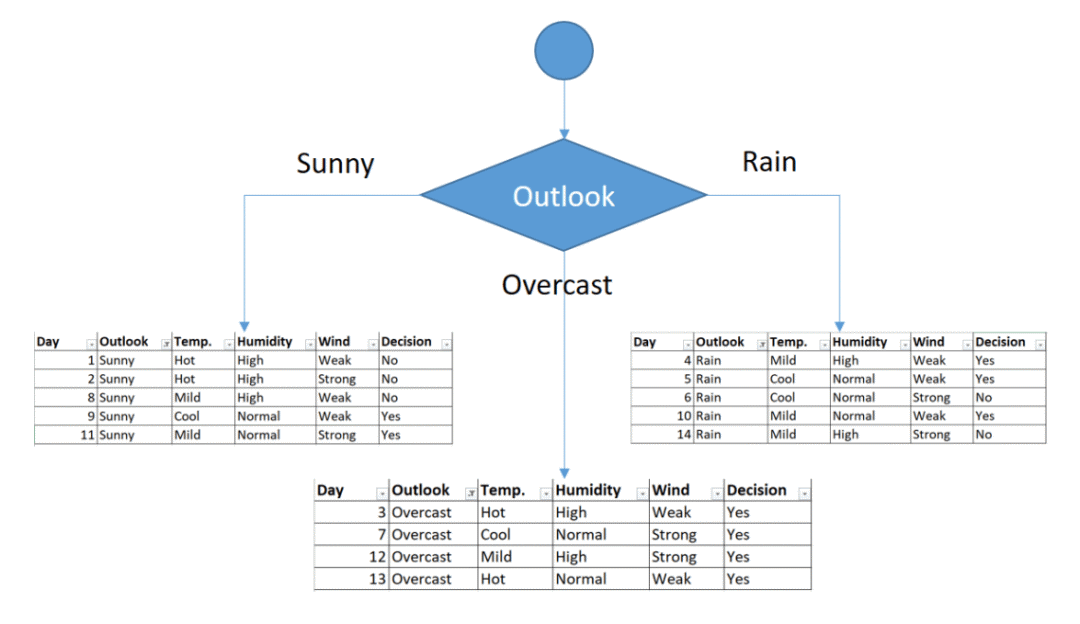
First decision would be outlook feature
You might realize that sub dataset in the overcast leaf has only yes decisions. This means that overcast leaf is over.
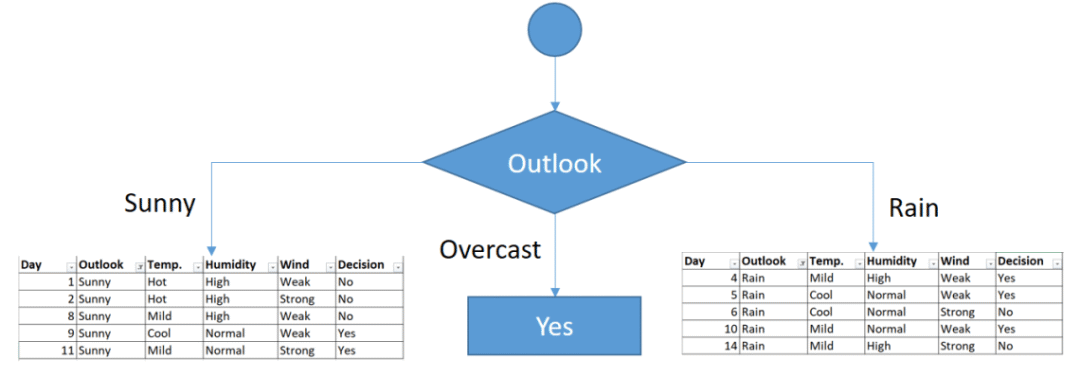
Tree is over for overcast outlook leaf
We will apply same principles to those sub datasets in the following steps.
Focus on the sub dataset for sunny outlook. We need to find the gini index scores for temperature, humidity and wind features respectively.
| Day | Outlook | Temp. | Humidity | Wind | Decision |
| 1 | Sunny | Hot | High | Weak | No |
| 2 | Sunny | Hot | High | Strong | No |
| 8 | Sunny | Mild | High | Weak | No |
| 9 | Sunny | Cool | Normal | Weak | Yes |
| 11 | Sunny | Mild | Normal | Strong | Yes |
Gini of temperature for sunny outlook
| Temperature | Yes | No | Number of instances |
| Hot | 0 | 2 | 2 |
| Cool | 1 | 0 | 1 |
| Mild | 1 | 1 | 2 |
Gini(Outlook=Sunny and Temp.=Hot) = 1 – (0/2)2 – (2/2)2 = 0
Gini(Outlook=Sunny and Temp.=Cool) = 1 – (1/1)2 – (0/1)2 = 0
Gini(Outlook=Sunny and Temp.=Mild) = 1 – (1/2)2 – (1/2)2 = 1 – 0.25 – 0.25 = 0.5
Gini(Outlook=Sunny and Temp.) = (2/5)x0 + (1/5)x0 + (2/5)x0.5 = 0.2
Gini of humidity for sunny outlook
| Humidity | Yes | No | Number of instances |
| High | 0 | 3 | 3 |
| Normal | 2 | 0 | 2 |
Gini(Outlook=Sunny and Humidity=High) = 1 – (0/3)2 – (3/3)2 = 0
Gini(Outlook=Sunny and Humidity=Normal) = 1 – (2/2)2 – (0/2)2 = 0
Gini(Outlook=Sunny and Humidity) = (3/5)x0 + (2/5)x0 = 0
Gini of wind for sunny outlook
| Wind | Yes | No | Number of instances |
| Weak | 1 | 2 | 3 |
| Strong | 1 | 1 | 2 |
Gini(Outlook=Sunny and Wind=Weak) = 1 – (1/3)2 – (2/3)2 = 0.266
Gini(Outlook=Sunny and Wind=Strong) = 1- (1/2)2 – (1/2)2 = 0.2
Gini(Outlook=Sunny and Wind) = (3/5)x0.266 + (2/5)x0.2 = 0.466
Decision for sunny outlook
We’ve calculated gini index scores for feature when outlook is sunny. The winner is humidity because it has the lowest value.
| Feature | Gini index |
| Temperature | 0.2 |
| Humidity | 0 |
| Wind | 0.466 |
We’ll put humidity check at the extension of sunny outlook.
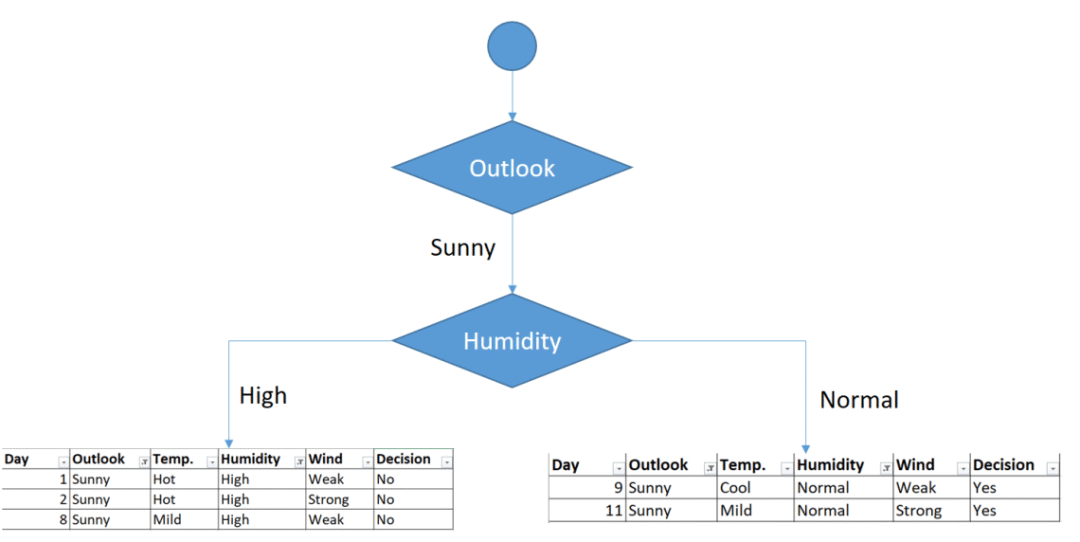
Sub datasets for high and normal humidity
As seen, decision is always no for high humidity and sunny outlook. On the other hand, decision will always be yes for normal humidity and sunny outlook. This branch is over.
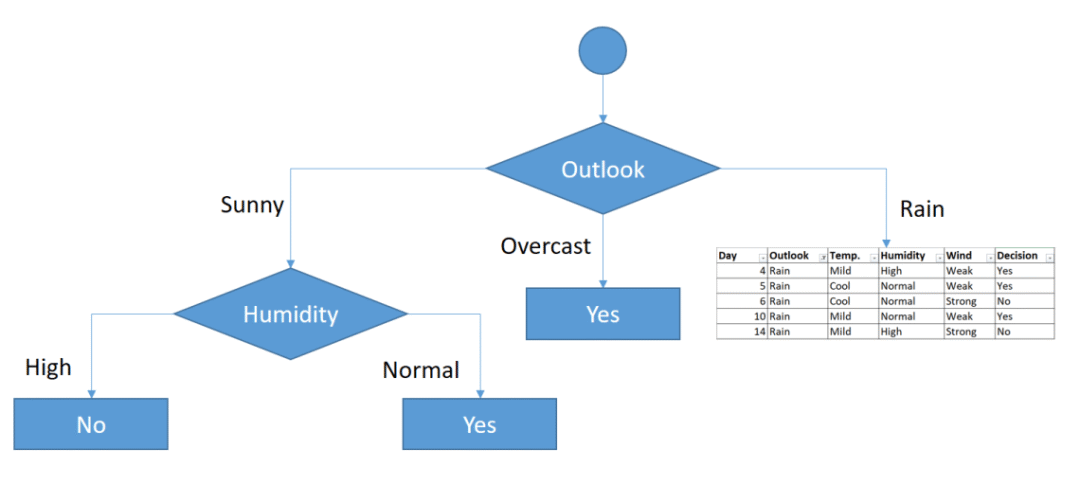
Decisions for high and normal humidity
Now, we need to focus on rain outlook.
Rain outlook
| Day | Outlook | Temp. | Humidity | Wind | Decision |
| 4 | Rain | Mild | High | Weak | Yes |
| 5 | Rain | Cool | Normal | Weak | Yes |
| 6 | Rain | Cool | Normal | Strong | No |
| 10 | Rain | Mild | Normal | Weak | Yes |
| 14 | Rain | Mild | High | Strong | No |
We’ll calculate gini index scores for temperature, humidity and wind features when outlook is rain.
Gini of temprature for rain outlook
| Temperature | Yes | No | Number of instances |
| Cool | 1 | 1 | 2 |
| Mild | 2 | 1 | 3 |
Gini(Outlook=Rain and Temp.=Cool) = 1 – (1/2)2 – (1/2)2 = 0.5
Gini(Outlook=Rain and Temp.=Mild) = 1 – (2/3)2 – (1/3)2 = 0.444
Gini(Outlook=Rain and Temp.) = (2/5)x0.5 + (3/5)x0.444 = 0.466
Gini of humidity for rain outlook
| Humidity | Yes | No | Number of instances |
| High | 1 | 1 | 2 |
| Normal | 2 | 1 | 3 |
Gini(Outlook=Rain and Humidity=High) = 1 – (1/2)2 – (1/2)2 = 0.5
Gini(Outlook=Rain and Humidity=Normal) = 1 – (2/3)2 – (1/3)2 = 0.444
Gini(Outlook=Rain and Humidity) = (2/5)x0.5 + (3/5)x0.444 = 0.466
Gini of wind for rain outlook
| Wind | Yes | No | Number of instances |
| Weak | 3 | 0 | 3 |
| Strong | 0 | 2 | 2 |
Gini(Outlook=Rain and Wind=Weak) = 1 – (3/3)2 – (0/3)2 = 0
Gini(Outlook=Rain and Wind=Strong) = 1 – (0/2)2 – (2/2)2 = 0
Gini(Outlook=Rain and Wind) = (3/5)x0 + (2/5)x0 = 0
Decision for rain outlook
The winner is wind feature for rain outlook because it has the minimum gini index score in features.
| Feature | Gini index |
| Temperature | 0.466 |
| Humidity | 0.466 |
| Wind | 0 |
Put the wind feature for rain outlook branch and monitor the new sub data sets.
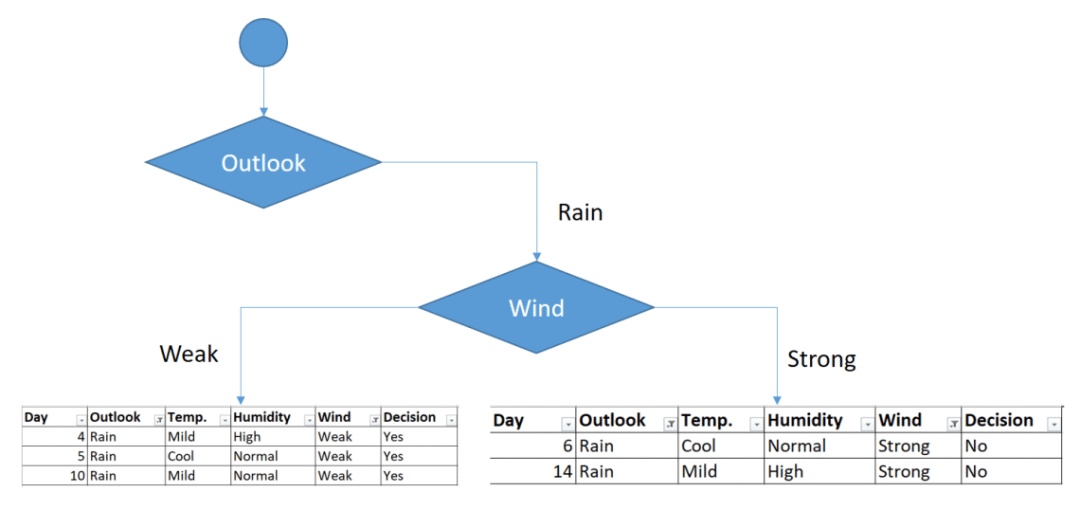
Sub data sets for weak and strong wind and rain outlook
As seen, decision is always yes when wind is weak. On the other hand, decision is always no if wind is strong. This means that this branch is over.
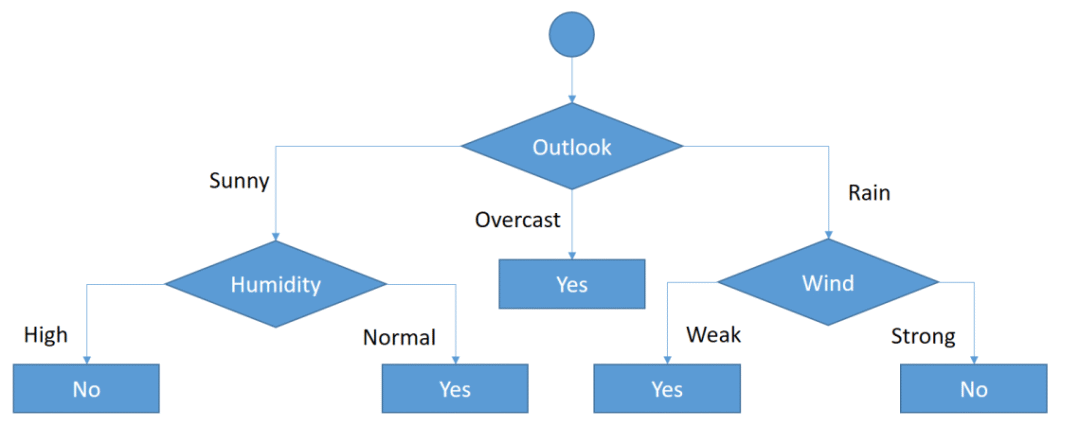
Final form of the decision tree built by CART algorithm
So, decision tree building is over. We have built a decision tree by hand. BTW, you might realize that we’ve created exactly the same tree in ID3 example. This does not mean that ID3 and CART algorithms produce same trees always. We are just lucky. Finally, I believe that CART is easier than ID3 and C4.5, isn’t it?






